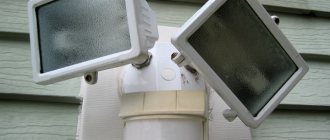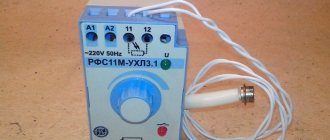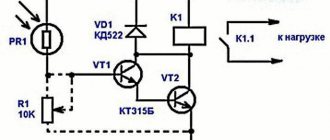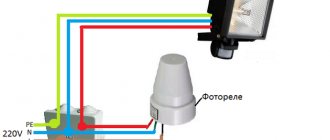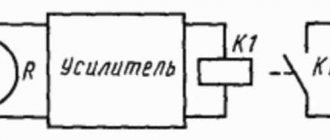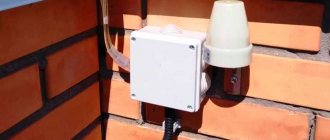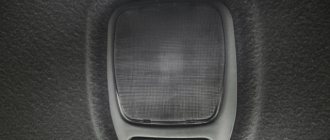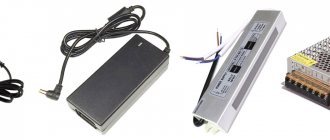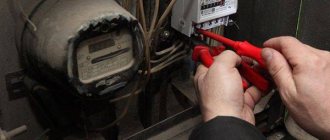Floodlights with photo relay or twilight switch are used to automate street lighting.
You can install such a device:
- in the courtyard and stairs of an apartment building;
- in the mall;
- at the outdoor advertising element and in shop windows;
- along streets and park paths;
- in parks;
- in the car park;
- in the video surveillance area;
- in the private sector - at the entrance to the house, on garden paths, near terraces, gazebos, barbecue areas.
In the city, photo sensors for street lighting are most often installed with housing and communal services type lamps. LED floodlights are used in private homes. To save energy, the twilight switch is combined with a motion sensor. In a private home, any home craftsman with a minimum of electrical knowledge can connect it.
Purpose and operating principle of photo relay
The purpose of a photosensor connected to the mains is to control the level of illumination based on the time of day. When it gets dark, the street lighting automatically turns on and turns off in the morning.
Any photo relay consists of the same parts:
- a photocell that senses light;
- comparator (current amplifier);
- transformer;
- relay (performer);
- motion sensor and timer or microcontroller (expensive models);
- magnetic starter (not always).
The resistance of the photocell changes depending on the level of illumination. With the onset of darkness it decreases, the comparator increases the current and transmits it to the relay that is connected to it. When it is triggered, the lamp lights up.
In the morning the process is reversed. Under the influence of light, the resistance of the photocell increases, the current voltage decreases, the comparator turns off the relay and the LED lamp.
Connecting multiple sensors to one spotlight
There are situations when it is necessary to control several zones to control one floodlight. For example, two entrances to a garage complex, or a car entrance and an entrance for pedestrians. It may turn out that one sensor cannot cover all zones. In this case, it is necessary to install several sensors so that each one controls its own territory. When connecting such sensors, two options are possible:
- When the output contact group of each sensor is designed to switch the full power of the spotlight, the contacts can be connected in parallel ("wiring OR" circuit).
Connecting two or more sensors directly to the spotlight (conductor N to the sensors is not shown for simplicity). - If the load capacity of the contact group of at least one or more detectors does not allow working with the selected spotlight directly, the sensors are also connected using the “mounted OR” circuit. But the illuminator is controlled through an intermediate relay or starter.
Connecting two or more sensors to the spotlight via a repeater relay (conductor N to the sensors is not shown for simplicity).
Important! It is a bad idea to connect two motion sensors in parallel without an intermediate starter, monitoring one zone, in order to “increase the load capacity” of the contact groups. No adjustment can achieve perfect simultaneity of sensors. This will cause one of the detectors to turn on earlier. As a result, both contact groups will fail.
Types of photo relay
There are 2 main types of twilight switches:
- with built-in photocell;
- with a photocell removed from the housing.
The first type of equipment has a sealed housing and increased resistance to negative environmental influences, therefore it is mounted outdoors (on a pole or wall). When using the second type, the switching unit is installed on a DIN rail in the panel, the photocell is connected using wires and installed outdoors (at a distance of up to 150 meters from the panel).
You can buy similar equipment for both single- and three-phase networks. Regardless of the network voltage, it is powered by 12 V supplied from the transformer.
The photocell is:
- resistor (resistance changes depending on light intensity);
- diode (works due to the photovoltaic effect, which forms an electric charge based on light intensity);
- transistor (optoelectronic semiconductor that changes the signal depending on the intensity of light);
- thyristor (optoelectronic semiconductor with a photosensitive matrix);
- triac (the current is regulated by a special circuit).
More complex models are equipped with:
- a motion sensor that turns on the lamp when a person is present;
- a timer that allows you to set the on/off time regardless of the actual light level;
- motion sensor and timer;
- threshold regulator;
- a microcontroller that allows you to turn the lamp on/off at certain hours.
The twilight switches have different timers (daily, weekly). The work period is set daily or for a certain period of time. If there is a threshold regulator, the photosensor has a knob for adjusting the level of illumination at which the lamp should light up. When you move the knob to minus, the light turns on only at night. If you move the knob to plus, the lamp will light up during rain or snowfall.
Devices with a microcontroller are equipped with an electronic display. They allow you to set different modes for different seasons.
Reference! An important feature is the ability to turn off the relay at night to reduce power consumption.
How to choose what to pay attention to
The main functions of a spotlight are to provide artificial light to specified spaces. The directed light flux creates comfortable conditions for people to live and perform work tasks. Individual preferences for choosing a floodlight as a lighting system for a particular object are influenced by many factors. The main selection criteria include:
Installation location and method
The place where the spotlights are installed is decisive: indoors or outdoors. Spotlights of different designs are installed depending on the area where the room is located. In order to place it on the surface, a bracket is used, and consoles are used to secure it at a height. On lighting masts, spotlights are placed in small holes and installed at the top of the arc.
Power
Depending on the area of the territory to be illuminated, a spotlight with a certain power is selected, which can reach from 10 to 200 W. To illuminate private areas, a power of up to 30 W is sufficient, and for large warehouses, more powerful lighting is needed, starting from 100 W and above. All spotlights are powered by 220 V and have class A energy consumption.
Degree of protection
When installing a floodlight outdoors, the protection class plays an important role. To maximize the protection of a luminaire placed outdoors from exposure to precipitation, dust and moisture, a protection indicator has been introduced that must correspond to outdoor devices within the limits of: IP64 or IP65 units. The larger the IP parameter, the more reliably the device is protected.
Color range
The shade of light that the spotlights emit is determined by the color temperature of warm, daytime and cold, and this indicator is measured in Kelvin (K).
- – up to 3500 K - this is a warm light, where not bright lighting is suitable for recreation areas;
- – 3500–5000 K – this is daylight, similar to solar lighting, used for work areas;
- – over 5000 K – cool white, bright light is used to illuminate large halls and areas.
Types of lamps
In different models of spotlights, lamps are used for lighting:
- – energy-saving, which ensure reliable, economical operation for a long time;
- – halogen, with high power, significant light output and long service life, used for lighting large areas;
- – LEDs are the most economical in terms of energy consumption and have high luminous efficiency, but are more expensive.
Material of manufacture
Typically, floodlights are made from steel or aluminum and plastic.
- Stainless steel is suitable for products installed outdoors. Its surface is not affected by atmospheric conditions and is resistant to corrosion. Steel products are heavy and designed to be installed low on a surface.
- Aluminum is a lightweight and non-corrosive metal, but can be deformed under physical stress. Spotlights made from its alloys are recommended to be installed higher, mounted on the walls.
- Plastic devices do not respond to weather conditions. This material is durable and not subject to corrosion.
Motion sensors
When turning the spotlights on/off, the devices respond in a time-efficient and energy-saving manner. They are triggered while moving through the territory intended for illumination of any objects within a given radius. Tuned to respond to electromagnetic and ultrasonic waves, they can cover illuminated areas within a radius of up to 20 meters.
Where to put
The installation location is selected so that the photocell is not exposed to light from a lamp, window, or advertising board. When the house is located near the roadway, the light from the lights of passing cars should not be directed at the device. The choice of location is limited by height requirements - 1.8-2 meters from the ground (if installed higher, a stool/chair or ladder/step-ladder will be required for adjustment).
Solving this problem is made easier by using some tricks. The photo sensor can be protected with a piece of black plastic pipe of the appropriate diameter, 15-20 cm long. The cutting angle is 30-45° from the pillar or wall. If there is only one spotlight, the photo relay is placed on the other side of the pole. The parameters are adjusted more accurately if the sensor is placed on the west or east side.
How to connect a photo relay: connection diagrams
To connect a photo relay to an LED spotlight, you must carefully study the instructions contained in the data sheet. Most photo sensors have a circuit on the body. Since the photo relay is similar in functionality (supply and power off) to a traditional switch, the installation also differs little.
Equipment with a built-in photocell can be connected via a distributor or without it. The distributor is used during repairs that involve replacing wiring. In such a situation, it is possible to draw a new line. If repairs are not carried out, it is not profitable to drill the walls for new wiring.
Varieties
At the moment there are several classifications of spotlights. So, there is a spotlight:
- industrial, street and decorative;
- for underwater, terrestrial, matrix, linear and panoramic lighting;
- LED, halogen and battery.
There is also the following classification: for indoor and outdoor lighting.
LED
The most popular and high-quality light source. Operates for 80 thousand hours. Does not require any maintenance throughout the entire period of use. It is used both in everyday life and in industry and commerce. Due to the high light flux density, it is used to illuminate a large area. The advantages include high efficiency, impact resistance, and safety. The disadvantage is the high cost.
LED apparatus
Solar powered
A modern system that allows you to completely eliminate network energy consumption. The floodlight is complemented by durable or built-in solar panels. They are used both to illuminate the facade of a building and an architectural element, and to maintain security and order in the local area. They work around the clock and autonomously, are very easy to install and maintain, and work regardless of the weather. It has an even and bright light flow and can be installed in any hard-to-reach place.
It is worth noting that during rain the performance of solar panels decreases. Therefore, sometimes the spotlight may turn off. Due to low temperatures, operation failure also occurs. The light becomes dimmer. Another disadvantage is that the equipment is not disassembled. As a result, if one element is damaged, you will need to completely buy new equipment.
Solar powered source
With halogen lamp
The halogen spotlight creates a spot-like, shadow-free lighting appearance that has a warm tint. This device is used to illuminate billboards or building facades. It is also used to illuminate large objects such as dams or bridges. The light bulb in it works the same way as an incandescent lamp. The only difference is the use of halogen instead of mercury. The advantages of such a device are low cost, high reliability and compatibility with dimmers. Disadvantages include high heating and energy consumption.
You might be interested in Lighting connection systems
There are also metal halide models. They are distinguished by a more powerful light flux, reliability and immunity to network current surges.
Note! They are actively used in commercial activities. They have a long service life.
Motion floodlight with built-in halogen lamps
Do-it-yourself installation and configuration: step-by-step instructions
To connect a photo relay to a lantern that is already on a pole, the power supply in the panel is turned off and the box is checked for voltage.
Sequence of actions when installing the device:
- pulling the power wire to the place where the switch to be connected will be installed;
- stripping the cores by 10-12 mm;
- drilling holes in the body;
- fastening seals in the holes that protect against moisture and dust;
- connecting wires in accordance with the diagram;
- a piece of wire for connecting to an LED spotlight;
- stripping the insulation by 10-12 mm;
- connecting wires to the LED spotlight;
- connecting the grounding to the socket (if the housing of the lighting equipment is made of metal).
It is better to use a three-wire wire for connecting the photosensor. It is placed on a pole or wall so that the holes are located at the bottom. This arrangement will protect from dust and moisture.
You can proceed to setting up the connected equipment. To simulate night, a black bag is included in the kit. There is a regulator on the body that allows you to select the light intensity at which the lamp should light up. The closer the regulator is to the minus sign, the later the LED lamp will turn on.
The last step is to connect to the network in the panel.
If you lack electrical knowledge, it is better to entrust the connection to a specialist.
Connection and setup
The installation of the spotlight should be done after assessing the area where it will be located. The following factors are taken into account:
- The height of the device so that it is inaccessible to intruders;
- The range of action of the motion sensor must correspond to the area of the area where lighting needs to be arranged;
- Possibility of servicing the lighting device.
To connect an automatic unit, you will need a three-core wire, the cross-sectional area of which is determined by the power of the lamp. The structure must be grounded, for which a dedicated grounding conductor or a power cable conductor can be used. The connection diagram requires connecting three wires: phase, neutral, power cable. Both the spotlight and the sensor are equipped with terminal boxes in which the wires are hidden. All connections are made using bolted connections.
As a rule, the connection diagram is indicated in the accompanying documentation of the lighting device. After installing the equipment, you should configure it. There are several switches on the motion sensor body:
- Sensitivity of the device - determines the level of operating efficiency;
- Light sensor – allows you to set a time frame for the operation of the spotlight, in particular, organize it to turn on only in the evening;
- Operating time – allows you to set the period during which the spotlight will remain on after the motion sensor is triggered.
Setting up the sensitivity device
By setting these three switches to the desired level, the light source can operate as efficiently as possible.
Spotlight installation
This lighting device must be connected to the electrical network via a three-wire cable and always via a circuit breaker. The recommended value of the circuit breaker protection current is three times higher than the power value of the lamp of the lighting device. The connection diagram must be drawn up so that it is the circuit breaker that disconnects the phase wire of the network.
The installation standards for floodlights and the requirements for this type of lighting fixtures are regulated by the relevant SNiP. Key points:
- spotlights can be installed on free-standing supports and on building facades;
- a bracket or cable is used as fastening;
- Spotlights of directed or diffused light are used to illuminate architectural objects and monuments.
Thus, a light source based on LEDs with an IR sensor can be called one of the most cost-effective solutions for arranging street lighting in large areas. The main advantages of such devices: low energy consumption, switching on only when a moving object appears, and no need for frequent maintenance.
Benefits of using photo relays for street lighting
If the twilight switch is configured correctly, monitor the condition of the housing during operation and wipe off dust from the photocell, it will serve for a long time.
The advantages of these devices include:
- compact body dimensions;
- silent operation;
- high productivity;
- increasing the level of safety due to the fact that in the dark the light turns on automatically;
- no need to monitor the switching on/off of street lighting;
- increasing the service life of LED floodlights.
With proper configuration of the photo relay, energy costs will be significantly reduced.
Operating principle of these systems
The design of an LED outdoor floodlight includes a housing, a power supply and the bulbs themselves. Fastening is carried out using a bracket. The luminous flux is adjusted using reflectors. If there is an automatic control unit, the device is connected to motion and light sensors. In this case, turning the lighting on and off occurs without human intervention.
Intense traffic in a protected area makes the installation of such systems impractical, since the light will constantly be in a blinking state as a result of the triggering of sensors that react to all movements.
An outdoor floodlight with a sensor is used as a backup source of outdoor lighting. Touch devices ensure that the backlight is activated at the right time. Due to this, controlling the spotlights becomes more convenient. The ideal conditions for the operation of such devices are considered to be night time with minimal traffic.
The operating principle of the system is based on the sensor triggering when movement begins in the controlled area. Sensors respond to electromagnetic radiation or ultrasound. Thermal radiation hits a special Fresnel lens, where it is brought into focus and then transmitted to an infrared sensor. Here the received data is processed using electronic devices.
The light sensor gives the command to turn on even in the absence of movement, when night gradually sets in and it becomes dark. During the daytime, the spotlight is switched off by photocells.
Main conclusions
The stores offer various models of this equipment, so everyone can choose what suits specific conditions. The connection diagram for a photo relay to an LED spotlight is not complicated, especially for the simplest models with two terminals.
If you have a minimum of electrical knowledge, you can save money if, instead of an expensive multifunctional model, you buy separately a photo sensor, a motion sensor and a timer. All devices are connected in series. If one element fails, you do not need to buy everything. When using an expensive multifunctional device, it is necessary to change it if one part fails.
Previous
FloodlightsHow to choose an LED floodlight with a motion sensor
Next
Spotlights DIY LED spotlight
The best floodlights with a motion sensor
Floodlights with motion sensors have many modifications. We have prepared a review of the TOP 7 popular models.
SPACE K-PR5-LED-20S 20 W
Outdoor LED floodlight with adjustable 3D motion sensor. The device is convenient because it can be rotated at any angle in the desired direction. It has a reliability class of IP65 and emits daylight at 6500K. The device operates from a 220 V network, with a power consumption of 20 W.
The motion sensor regulates the spotlight's operating mode and range, the parameters of which are adjusted during installation of the equipment. The following functions can be set:
– determine the level of dimming required to turn on;
– set the sensor range from 5 to 10 m;
– set the permissible object illumination time from 10 seconds to 7 minutes.
ADVANTAGES:
- compactness
- sensitive motion sensor
- bright enough light
- along a straight trajectory confidently responds to movement up to 10 meters
- has a wide range of coverage in width (up to 8 – 10 meters in each direction)
FLAWS
- not detected
SPACE K-PR5-LED-20S 20 W
Glanzen FAD-0017-10 10 W
The LED floodlight under the German brand “Glanzen” for the production of electrical goods is equipped with a motion sensor. The product is made in Russia and complies with international standards.
Street floodlight with dimensions 170x84x38 mm. made of aluminum. Weighs 0.25 kg, such illuminators are usually placed on the facades of buildings and structures with mounting on an arc.
According to its technical characteristics, GLANZEN FAD-0017-10 has a power of 10 W, with a degree of protection IP65 units, with cool white, bright light with a color temperature of 6000-6500K and a luminous flux of 900 Lm. The device is suitable for installation in the garden, on construction sites, on industrial buildings with a service life of at least 50,000 hours.
ADVANTAGES:
- low price
- Easy to adjust the direction of the motion sensor
- aluminium case
- The motion sensor works flawlessly
- shines brightly
FLAWS
- very thin wires, they need to be connected only through the terminals, otherwise they will break
- there are many reviews about the short service life (up to six months)
Glanzen FAD-0017-10 10 W
Ritex LED-265 7 W
A compact LED floodlight with a motion sensor is produced in China under the Japanese brand Ritex. Power is supplied by D x 3 batteries, which are not included in the package.
The device has 2 lighting modes with a glow duration of 5 and 20 s and a 3rd mode – security mode, when when the motion sensor is triggered, the spotlight begins to pulsate with bright flashes for 20 s. The light beam is directed at different angles in any direction, thanks to rotation with a detection range of 140 and 6 m.
The original model of the RITEX LED-265 floodlight is made of black plastic and has a battery life of about 420 days. The device has increased brightness from 2 LED lamps with a total power of 7 W, with a luminous flux of 600 lm and a degree of protection of IP44.
The wide capabilities of the floodlight with a motion sensor Ritex LED-265 7 W are used for lighting street spaces and protecting the perimeter of the territory.
ADVANTAGES:
- ease of installation (even women can do it)
- battery operated
- illuminates well
- If water gets in during rains, it continues to work without interruption
- the sensor always responds well to movements
FLAWS
- no batteries included
Ritex LED-265 7 W
IEK SDO 06-50D (6500K) 50 W
LED floodlights with motion sensors are produced in Russia. Electrical devices comply with GOST and quality according to international standards.
The shockproof body of the product is black, with dimensions 183x30x150, made of aluminum. It provides durability with IP54 protection.
The lamps are powered by a voltage of 220 V, energy efficient with a power consumption of 50 W, with a luminous flux of 400 Lm. They emit cool white light with a color temperature of over 6500 K.
Floodlights are installed on a mounting arc; they are used to protect large areas of industrial facilities, warehouses, parking lots and entrances to multi-story buildings. The average shelf life is at least 50,000 hours.
ADVANTAGES:
- good value for money
- compactness
- brightness
- slim body
- operating temperature range from -45° to +50°С
FLAWS
- non-separable body
- During continuous operation, condensation forms inside the housing, which disables the spotlight
IEK SDO 06-50D (6500K) 50 W
Volta WFL-50W/05s 50 W
The customizable motion sensor allows you to set the ambient light threshold when the motion sensor is triggered from 3 lux (night time) to 2000 lux (daylight).
The lamps can be used for outdoor and indoor lighting.
The shutdown delay time is adjustable from 10 (±3) seconds to 7 (±2) minutes. The sensor range is 8 meters. When the motion sensor is triggered, the spotlight turns on instantly.
ADVANTAGES:
- high quality materials and workmanship
- clear operation of the motion sensor
- bright lighting
- sealed housing
- Suitable for both indoor and outdoor lighting
FLAWS
- the sensor cannot be turned to the side
Volta WFL-50W/05s 50 W
ERA ERA FS048-08
A facade lamp with a motion sensor is produced by St. Petersburg. A distinctive feature of the spotlight is its autonomous power supply from the built-in solar battery.
6 LEDs emit cool white light with a bright luminous flux and consume energy accumulated throughout the day. The LED emitter has two glow modes:
– static is intended for autonomous lighting after dark;
– a worker with a brighter luminous flux reacts to movement within a radius of 5 m.
The lamp body is made of gray plastic with protection class IP44, with a service life guarantee of 2 years. The product is permanently installed on the facades of private houses and country houses.
ADVANTAGES:
- compact, 15*11*6.5 cm.
- runs on solar battery
- has two glow modes
- nice design
- 2 year warranty
FLAWS
- According to reviews, the housing is not sealed (it floods with rain)
ERA ERA FS048-08
Philips BVP150 LED17/NW 20 W
The well-known Dutch company, the Netherlands, has production in China and produces BVP150 LED17/NW floodlights 220-240V 20W. These company products not only look aesthetically pleasing, they meet modern requirements for reliability and environmental friendliness, which is confirmed by the EcoDesign examination.
The wall-mounted housing of the floodlight is made of aluminum with dust and moisture protection class IP65. Contains a built-in 20 W LED lamp with a luminous flux of 1700 lm. The lamp emits natural white light with a color temperature of 4000 K.
Non-equipped with a built-in motion sensor, a stationary device is installed on the surface using mounting arcs. The lamp has dimensions: 13.2 x 14 x 2.8 cm
ADVANTAGES:
- powerful, meets the stated characteristics
- color temperature corresponds to the description
- bright light, virtually no flicker
- high-quality assembled case
- there is a diffuser glass - the light falls evenly, not in a spot
FLAWS
- not detected
Philips BVP150 LED17/NW 20 W
